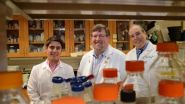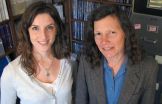(Press-News.org) Americans take electrical power for granted whenever they flip on a light switch. But the growing use of solar and wind power in the United States makes the on-demand delivery of electricity more challenging.
A key problem is that the U.S. electrical grid has virtually no storage capacity, so grid operators can't stockpile surplus clean energy and deliver it at night, or when the wind isn't blowing.
To provide more flexibility in managing the grid, researchers have begun developing new batteries and other large-scale storage devices. But the fossil fuel required to build these technologies could negate some of the environmental benefits of installing new solar and wind farms, according to Stanford University scientists.
"We calculated how much energy it will cost society to build storage on future power grids that are heavily supplied by renewable resources," said Charles Barnhart, a postdoctoral fellow at Stanford's Global Climate and Energy Project (GCEP) and lead author of the study. "It turns out that that grid storage is energetically expensive, and some technologies, like lead-acid batteries, will require more energy to build and maintain than others."
The results are published in a recent online edition of the journal Energy & Environmental Science.
Most of the electricity produced in the United States comes from coal- and natural gas-fired power plants. Only about 3 percent is generated from wind, solar, hydroelectric and other renewable sources. The Stanford study considers a future U.S. grid where up to 80 percent of the electricity comes from renewables.
"Wind and solar power show great potential as low-carbon sources of electricity, but they depend on the weather," said co-author Sally Benson, a research professor of energy resource engineering at Stanford and the director of GCEP.
"As the percentage of electricity from these sources increases, grid operators will need energy storage to help balance supply with demand. To our knowledge, this study is the first to actually quantify the energetic costs of grid-scale storage over time."
Pumped hydro
The total storage capacity of the U.S. grid is less than 1 percent, according to Barnhart. What little capacity there is comes from pumped hydroelectric storage, a clean, renewable technology. Here's how it works: When demand is low, surplus electricity is used to pump water to a reservoir behind a dam. When demand is high, the water is released through turbines that generate electricity.
For the Stanford study, Barnhart and Benson compared the amount of energy required to build a pumped hydro facility with the energetic cost of producing five promising battery technologies: lead-acid, lithium-ion, sodium-sulfur, vanadium-redox and zinc-bromine.
"Our first step was to calculate the cradle-to-gate embodied energy," Barnhart said. "That's the total amount of energy required to build and deliver the technology – from the extraction of raw materials, such as lithium and lead, to the manufacture and installation of the finished device."
To determine the amount of energy required to build each of the five battery technologies, Barnhart relied on data collected by Argonne National Laboratory and other sources. The data revealed that all five batteries have high embodied-energy costs compared with pumped hydroelectric storage.
"This is somewhat intuitive, because battery technologies are made out of metals, sometimes rare metals, which take a lot of energy to acquire and purify," Barnhart said. "Whereas a pumped hydro facility is made of air, water and dirt. It's basically a hole in the ground with a reinforced concrete dam."
After determining the embodied energy required to build each storage technology, Barnhart's next step was to calculate the energetic cost of maintaining the technology over a 30-year timescale. "Ideally, an energy storage technology should last several decades," he said. "Otherwise, you'll have to acquire more materials, rebuild the technology and transport it. All of those things cost energy. So the longer it lasts, the less energy it will consume over time as a cost to society."
To quantify the long-term energetic costs, Barnhart and Benson came up with a new mathematical formula they dubbed ESOI, or energy stored on investment. "ESOI is the amount of energy that can be stored by a technology, divided by the amount of energy required to build that technology," Barnhart said. "The higher the ESOI value, the better the storage technology is energetically."
When Barnhart crunched the numbers, the results were clear. "We determined that a pumped hydro facility has an ESOI value of 210," he said. "That means it can store 210 times more energy over its lifetime than the amount of energy that was required to build it."
The five battery technologies fared much worse. Lithium-ion batteries were the best performers, with an ESOI value of 10. Lead-acid batteries had an ESOI value of 2, the lowest in the study. "That means a conventional lead-acid battery can only store twice as much energy as was needed to build it," Barnhart said. "So using the kind of lead-acid batteries available today to provide storage for the worldwide power grid is impractical."
Improved cycle life
The best way to reduce a battery's long-term energetic costs, he said, would be to improve its cycle life – that is, increase the number of times the battery can charge and discharge energy over its lifetime. "Pumped hydro storage can achieve more than 25,000 cycles," Barnhart said. "That means it can deliver clean energy on demand for 30 years or more. It would be fantastic if batteries could achieve the same cycle life."
None of the conventional battery technologies featured in the study has reached that level. Lithium-ion is the best at 6,000 cycles, while lead-acid technology is at the bottom, achieving a mere 700 cycles.
"The most effective way a storage technology can become less energy-intensive over time is to increase its cycle life," Benson said. "Most battery research today focuses on improving the storage or power capacity. These qualities are very important for electric vehicles and portable electronics, but not for storing energy on the grid. Based on our ESOI calculations, grid-scale battery research should focus on extending cycle life by a factor of 3 to 10."
In addition to energetic costs, Barnhart and Benson also calculated the material costs of building these grid-scale storage technologies.
"In general, we found that the material constraints aren't as limiting as the energetic constraints," Barnhart said. "It appears that there are plenty of materials in the Earth to build energy storage. There are exceptions, such as cobalt, which is used in some lithium-ion technologies, and vanadium, the key component of vanadium-redox flow batteries."
Pumped hydro storage faces another set of challenges. "Pumped hydro is energetically quite cheap, but the number of geologic locations conducive to pumped hydro is dwindling, and those that remain have environmental sensitivities," Barnhart said.
The study also assessed a promising technology called CAES, or compressed air energy storage. CAES works by pumping air at very high pressure into a massive cavern or aquifer, then releasing the compressed air through a turbine to generate electricity on demand. The Stanford team discovered that CAES has the fewest material constraints of all the technologies studied, as well as the highest ESOI value: 240. Two CAES facilities are operating today in Alabama and Germany.
Global warming impact
A primary goal of the study was to encourage the development of practical technologies that lower greenhouse emissions and curb global warming, Barnhart said. Coal- and natural gas-fired power plants are responsible for at least a third of those emissions, and replacing them with emissions-free technologies could have a dramatic impact, he added.
"There are a lot of benefits of electrical energy storage on the power grid," he said. "It allows consumers to use power when they want to use it. It increases the amount of energy that we can use from wind and solar, which are good low-carbon sources."
In November 2012, the U.S. Department of Energy launched the $120 million Joint Center for Energy Storage Research, a nationwide effort to develop efficient and reliable storage systems for the grid. The center is led by Argonne National Laboratory in partnership with the SLAC National Accelerator Laboratory at Stanford and a dozen other institutions and corporations. Part of the center's mission is to develop new battery architectures that improve performance and increase cycle life – a direction that Barnhart and Benson strongly support.
"I would like our study to be a call to arms for increasing the cycle life of electrical energy storage," Barnhart said. "It's really a basic conservative principal: The longer something lasts, the less energy you're going to use. You can buy a really well-made pair of boots that will last five years, or a shoddy pair that will last only one."
INFORMATION:
The study was supported by GCEP and its sponsors – ExxonMobil, GE, Schlumberger and DuPont.
This article was written by Mark Shwartz, Precourt Institute for Energy, Stanford University.
Stanford scientists calculate the carbon footprint of grid-scale battery technologies
2013-03-08
ELSE PRESS RELEASES FROM THIS DATE:
Home toxic home
2013-03-08
EAST LANSING, Mich. — Most organisms would die in the volcanic sulfur pools of Yellowstone and Mount Etna. Robust simple algae call it home, and their secrets to survival could advance human medicine and bioremediation.
Mike Garavito, Michigan State University professor of biochemistry and molecular biology was part of a research team that revealed how primitive red algae use horizontal gene transfer, in essence stealing useful genes from other organisms to evolve and thrive in harsh environments.
Their study, published in the current issue of Science, shows that the ...
Anti-aging drug breakthrough
2013-03-08
Drugs that combat ageing may be available within five years, following landmark work led by an Australian researcher.
The work, published in the March 8 issue of Science, finally proves that a single anti-ageing enzyme in the body can be targeted, with the potential to prevent age-related diseases and extend lifespans.
The paper shows all of the 117 drugs tested work on the single enzyme through a common mechanism. This means that a whole new class of anti-ageing drugs is now viable, which could ultimately prevent cancer, Alzheimer's disease and type 2 diabetes.
"Ultimately, ...
Virus and genes involved in causation of schizophrenia
2013-03-08
Viruses and genes interact in a way that may increase the risk of developing schizophrenia significantly. This happens already in the developing foetus.
An international team of scientists led by Aarhus University, Denmark, has made this discovery. As the first in the world, they scanned the entire genome of hundreds of sick and healthy people to see if there is an interaction between genes and a very common virus - cytomegalovirus - and to see whether the interaction influences the risk of developing schizophrenia.
And it does.
Women that have been infected by the virus ...
Specialised germanium surface as universal protein adapter
2013-03-08
Researchers at the Ruhr Universität Bochum have developed a new method for attaching proteins to the surface of germanium crystals – for the first time also membrane proteins. This enables time-resolved tracking of the interactions between molecules using infrared spectroscopy in a way that is accurate down to atomic resolution. The method is applied in the EU project "Kinetics for Drug Discovery, K4DD", in which scientists explore the interplay of drugs and their interaction partners. With the new technology, the researchers can also study so-called G-protein-coupled receptors, ...
Maternal obesity increases the risk of frequent wheezing in offspring
2013-03-08
The fact that excess weight during pregnancy has negative consequences is not new information. A new study now concludes that the children of mothers obese before falling pregnant are four times more likely to have frequent wheezing, which is one of the symptoms of asthma, compared to the children of mothers weighing a normal weight.
Researchers from the Centre for Research in Environmental Epidemiology (CREAL) assessed whether obesity in mothers increases the risk of their children having frequent wheezing, a symptom associated with susceptibility to asthma during infancy ...
Signaling molecule may help stem cells focus on making bone despite age, disease
2013-03-08
AUGUSTA, Ga. – A signaling molecule that helps stem cells survive in the naturally low-oxygen environment inside the bone marrow may hold clues to helping the cells survive when the going gets worse with age and disease, researchers report.
They hope the findings, reported in PLOS ONE, will result in better therapies to prevent bone loss in aging and enhance success of stem cell transplants for a wide variety of conditions from heart disease to cerebral palsy and cancer.
They've found that inside the usual, oxygen-poor niche of mesenchymal stem cells, stromal cell-derived ...
Scientists discuss relationship between abortion and violence against women
2013-03-08
This press release is available in Spanish.
New York, March 8th 2013 – Scientists of the United States of America, Ireland, and Chile met this week in New York to discuss recent scientific evidence regarding abortion as a form of growing violence against women and girls. Indiscriminate practice of abortion is significantly correlated with coercion, a history of sexual abuse, violence during pregnancy, intimate partner violence, and with psychological consequences that may lead to suicide.
The scientific evidence was discussed by Doctors Monique Chireau (North Carolina, ...
Wayne State researcher gives new name to exhaustion suffered by cancer patients
2013-03-08
DETROIT — The fatigue experienced by patients undergoing cancer treatments has long been recognized by health care providers, although its causes and ways to manage it are still largely unknown.
A Wayne State University researcher believes the condition affects some patients much more than others and is trying to determine the nature of that difference.
Horng-Shiuann Wu, Ph.D., assistant professor of nursing in the College of Nursing, has made an effort to chronicle the parameters of what she calls sudden exhaustion syndrome. Her study, "Definition, Prevalence and Characteristics ...
Institutional betrayal magnifies post-trauma effects of unwanted sexual activity
2013-03-08
EUGENE, Ore. -- (March 8, 2013) -- A study of 345 female university students found that 233 of them had experienced at least one unwanted sexual experience in their lifetime, and 46 percent of those victims also experienced betrayal by the institution where incidents occurred. In the final analysis, researchers found, those who experienced institutional betrayal suffered the most in four post-trauma measurement categories, including anxiety and dissociation.
The study by the University of Oregon's doctoral student Carly Parnitzke Smith and Jennifer J. Freyd, professor ...
Hospitalizations for congenital heart disease increasing at greater rate among adults than children
2013-03-08
Jared M. O'Leary, M.D., of Brigham and Women's Hospital, Boston, and colleagues analyzed U.S. hospitalizations from 1998 through 2010 for children and adults with congenital heart disease. "There are more than 787,000 adults with congenital heart disease in the United States. Adults with congenital heart disease remain at risk for frequent hospitalizations," the authors write in a Research Letter published online by JAMA to coincide with its presentation at the American College of Cardiology's annual Scientific Sessions.
The researchers identified congenital heart disease ...




